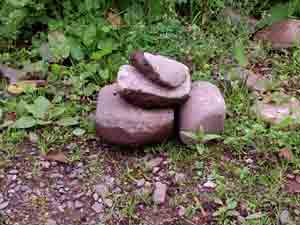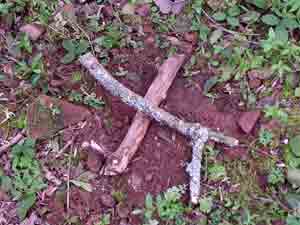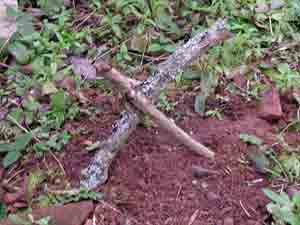The Onshore Option
So you don't want to use the intertidal zone? Maybe the tide's in, or maybe you really don't want to go anywhere near those slippy wet rocks? No problem - have trowel, can deal with the problem on land. In fact, if you're using a bothy, the chances are that there may well be a shovel or spade provided and some bothys even have instructions as to where the best place is. On Raasay's north end, the instructions in the bothy there suggests the view to the West is best.
Once again, a little gentle exercise is called for, again clutching your Bog Bag. Stroll away for a decent distance, picking up a couple of bits of stick on the way. According to Kathleen Meyer (1994) in her seriously good book "How to Shit in the Woods" (links to Amazon), you're aiming to get at least 150 feet (call that 50 paces or so) from any likely drinking water source - and that is really important - and away from places folk are likely to move around on or camp. Into a forest is quite good - or perhaps over that wee hill behind your tent or the bothy? Please don't dig a hole in machair though - it's a very fragile environment and recovery can take many years.
Making sure you're away from water sources is important - human crap carries a large number of nasty pathogens and these can travel a surprisingly long way through the soil. Water sources include that nice, soft, easy-to-dig in boggy bit seeing as how it's the likely source for the wee stream that's just down hill. You know, the one you fill your water bottle from?
Now we need another of those holes. You don't have to dig to China, all you need is to go down maybe six inches or so. Meyer notes that the 'most effective enzymes for breaking down excrement live in the top eight inches of the soil'. Enzymes are good - nature at work. The trowel comes in handy here, or perhaps one of those sticks you picked up. At the very least, you could scrape a "cat hole" with the heel of your boot.
Trousers down and do what comes naturally.
At this point, we have more choices folks. We can burn the toilet paper and I have to say that's my favourite method BUT we've now got a potential fire risk to consider, especially if the ground is dry. Setting the heather alight or burning down a forest is not the low-impact sort of camping we're trying to achieve. Where I think there is a likelihood of recreating Towering Inferno, I have another strategy.
On with the gloves - collect the used paper - slip it into a ziplock and seal it - remove the gloves and put them and the original ziplock into another ziplock and seal! Easy innit? If you want, you can package this lot up and take it away for disposal. Personally I drop the lot into a well burning fire and have done with it. Yes, burning plastic creates some hydrocarbons but they are going to get created anyway at some stage and I believe the impact is less than leaving used toilet paper lying round the countryside.
Again, grass or moss makes a very acceptable natural alternative, but do watch out for nettles or other prickly things!
Whichever way you deal with the used paper, Meyer suggests using one of your sticks to do a little gentle stirring of the pile to try and get some soil from the edges of the hole in contact with the nasty stuff - not something that comes naturally to me I have to say, but Meyer's book tells us that this helps break down the crap by 'bringing soil bacteria in contact with more of the faecal matter, so aiding decomposition'.
The SCA advice on Where to "go" in the Wilderness offers similar ideas - incidentally, it specifically advises that "squashing excrement under a boulder will slow the decomposition process and should never be done. If other techniques canít be used then a final option is to cover the excrement with a rock in such a way that the rock and excrement aren't in contact. This allows air to circulate and thereby enables decomposition."
Once again I recommend marking the spot - another small cairn, or "X marks the spot" and those sticks can be laid crossed on the ground, or stuck in the ground in such a manner as to make a vertical cross on it's side - like a big X. That's how the Scouts mark "foul ground" and there isn't much that they don't know about living outdoors.
 |
 |
 |
The "rock sculpture" approach to marking
the spot - but not as a way of "hiding" your do-do's! |
Crossed sticks, just laid on the ground - easy to kick over or miss, so perhaps not the best. |
An "X" made of the same sticks stuck in the ground at 45 degree - slightly more substantial and obvious. |
Again, wash the hands. But of course as we're 150 feet away from any water, and as you wouldn't be doing that washing in the burn or stream anyway would you, that's where the wet-ones come into their own. Pack out or burn in the fire afterwards.
(By the way, sanitary towels, tampons and the like should all be either burned in a fire or packed out with you - they don't seem to decompose at all well, even buried. Bring a few disposal bags nicked from the ladies at work if this embarrasses you (or use a zip-lock) and discretely dump in the fire.)
Groups, especially "organised groups", could consider the merit of a communal latrine trench - it need not be especially large, perhaps 6 or 9 inches wide by a few foot long. Carrying one of the readily available folding "trenching tools" in a group should be practical and if the sods are carefully removed and laid aside they can be replaced once the trench is backfilled before leaving the area.
After use each individual covers up his own material (that's poop, btw) with some of the excavated earth. As previously suggested, paper is either burned or packed out rather than being buried. On departure, backfill, replace the sods and mark the spot. Give it a few days or so and there will be no trace.
For the commercial trip operators, a question. Do you provide latrines, a porta-potti, or at least some guidance for your paying clients, or just leave them to struggle in the wilderness? I guess perhaps if you're a client you might want to ask your trip organiser what their toileting arrangements are, given that they are making a living out of the beautiful, wild places they are taking you to.
Another option that's just come on the market is something called The Green Loo - a foldable and transportable toilet system that uses bio-degradable plastic bags to hold waste. After use, the bag(s) can easily be taken away for disposal, or buried in a suitable latrine pit dug for the purpose. As the bag degrades, the contents leech into the soil. Certainly I believe it is something for groups, especially commercial one, to give serious consideration to.
An alternative worth considering - the Poop Tube - a neat way of packing out human waste, made from pvc pipe.
If you don't know, or are unsure of what to do or how to cope, make a point of asking. The good commercial operators will offer support and (with a bit of luck) may even provide some resources to help you.
| Go Back to the previous page |
| Mike Buckley - September, 2004. | (Page updated
21-Mar-2016
) |
|